We had a brief pause in work a few days ago when there was a partial solar eclipse (about 70%). Some people seemed to be using X-ray film to view the eclipse, which apparently does not protect your eyes. Perhaps they were using something else. Looking at the sun can be extremely dangerous and cause lasting damage to your eyes. A list of safe ways to view solar eclipses is listed here:
http://eclipse.gsfc.nasa.gov/SEhelp/safety.html
Not being prepared for the eclipse, I just used the pinhole method as described from a quick Google search. With a pencil I stabbed a hole into one sheet of white A4 printer paper. By holding this paper up to the light from the sun and letting the light shine through onto the second piece of paper, I could see the shape of the eclipse on the second piece of paper. Very easy and pretty cool to see.
It did get dimmer for some time, but not much more than when a cloud covers the sun. A long time ago I witnessed an eclipse of about 80%, this was enough to give a sort of early evening light, to the extent that our pets expected it was dinner time. I was also lucky enough to witness a full solar eclipse once in Antalya, Turkey. This ranks high on my list on most breathtaking things ever seen, and in this case it did get quite dark, although not as dark as I had expected (you could still see around). The sun appeared like a golden, burning ring covered by a dark circle, and everything seemed quite surreal. At the peak of the eclipse we did remove our glasses and look directly at it, as it was hypnotically beautiful (and apparently it is safe at this stage). In this case the conference I was at supplied us with special glasses to watch the eclipse as you can see in the photos. If you can plan to be in an area when a total eclipse of the sun is occurring, it is definitely worthwhile.





